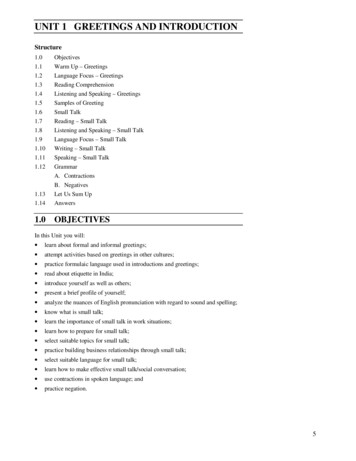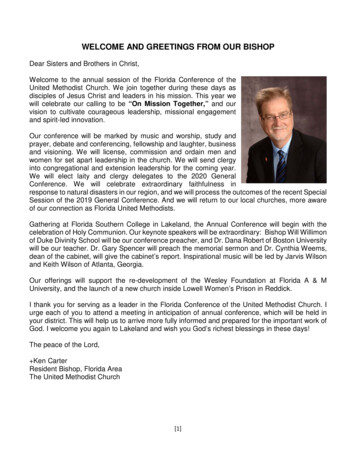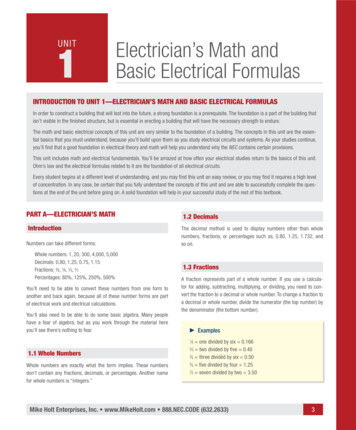
Transcription
UNIT 1 GREETINGS AND INTRODUCTIONStructure1.0Objectives1.1Warm Up – Greetings1.2Language Focus – Greetings1.3Reading Comprehension1.4Listening and Speaking – Greetings1.5Samples of Greeting1.6Small Talk1.7Reading – Small Talk1.8Listening and Speaking – Small Talk1.9Language Focus – Small Talk1.10Writing – Small Talk1.11Speaking – Small Talk1.12GrammarA. ContractionsB. Negatives1.131.14Let Us Sum UpAnswers1.0 OBJECTIVESIn this Unit you will: learn about formal and informal greetings; attempt activities based on greetings in other cultures; practice formulaic language used in introductions and greetings; read about etiquette in India; introduce yourself as well as others; present a brief profile of yourself; analyze the nuances of English pronunciation with regard to sound and spelling; know what is small talk; learn the importance of small talk in work situations; learn how to prepare for small talk; select suitable topics for small talk; practice building business relationships through small talk; select suitable language for small talk; learn how to make effective small talk/social conversation; use contractions in spoken language; and practice negation.5
Business Social Skills andthe Recruitment Process1.1 WARM UP – GREETINGSActivity 1i) How do you introduce yourself to a new colleague at work?ii) How do you greet your colleagues when you meet them?a)b)c)d)at home?at a party?at a get-together?in a formal meeting?iii) Find someone who This activity will help you to get introduced to other members of your study group.Your trainer will ask you to pick up slips of paper from a pool. Move around in thegroup and find someone who does or likes what’s written on the slip.Find someone who has no workexperience.Find someone who likes to live in a jointfamily.Find someone who doesn’t like cricket.Find someone who is a member of anenvironment group.Find someone whose native place is thesame as yours.Find someone who writes with his/herleft hand.Find someone who knows four languagesor more.Find someone whose name begins with T.Find someone who plays a musicalinstrument.Find someone who is a sportsperson.1.2 LANGUAGE FOCUS – GREETINGSActivity 21) Now listen to these greetings and state whether they are formal, semi-formal orinformal. Check your responses with the ‘Answers Section’.i)ii)iii)iv)v)vi)vii)viii)ix)x)6Hi!How do you do?How are you doing?What’s up?Hello!How are you?Good Morning / Afternoon / EveningGood to see you.How’s it going?How are things?
2) Match the responses with the greetings:GreetingGreetings andIntroductionResponseiHiaVery well, thank you. And you?iiHow do you do?bHello / hiiiiHow are you doing?cGood to see you too.ivWhat’s up?dHow do you do?vHelloeNothing much.viHow are you?fGood Morning / afternoon / eveningviiGood Morning / afternoon /eveninggAlright. How about you?hHi / helloviii Good to see you3) Introducing YourselfDo not sayI’m Anjana Iyer.My name’s Anjana Iyer.Myself Anjana Iyer.There are a number of phrases that are commonly used to introduce strangers.I don't think you've metRadhika?For Example:Can you think of at least two other ways in which you can introduce someone tothe others? Check the ‘Answers Section’ for more alternatives.4) Here are some typical corporate situations where you need to greet people.Match the situation to the appropriate dialogue box. Now practice theconversation with your partner.Situations:A Receiving a foreign customer at the airportB Running into someone you know at a conferenceC After being introduced to someone at a business event e.g. Trade FairD Meeting someone in a restaurant for a business lunch to which you’ve beeninvitedE Receiving an important visitor in your cabinDialogue Boxesi)ii)You:B:You:A:You:A:You:How are you? I hope I didn’t keep you waiting too long!Fine thanks. I arrived a couple of minutes ago.Nice place. Have you ordered anything yet?Hello!Oh Hi! Imagine running into you like this.Yes, it’s so good to see you after such a long time. How have you been?Great! How about you?7
Business Social Skills andthe Recruitment :Iyer:How do you do, Mr. Shwartz?How do you do?Did you have a comfortable flight?Not too bad, thank you.Good morning Mr. Iyer. I’ve been waiting to see you.It’s good to see you too.How are you?I’m fine thank you.You:It’s a pleasure to meet you Mr. Chhabra. How doyou do?Chhabra: Fine thank you. I’m pleased to meet you too.v)5) When you meet someone the first time in a formal situation, it is common to greetthe person with "How do you do?" the correct response to this is also "How doyou do." However, the stress pattern is different in both cases. The stress ismarked for you in the given box:A:B:How do you do?How do you do?Alternatively the response can be:A:B:How do you do?Fine thank you. How do you do?If you find “How do you do?” too formal you may choose to greet someonestraight away with “Pleased to meet you.” In this case the response would be“Pleased to meet you too.” The stress pattern will be as follows:A: Pleased to meet you, Mr. Raghavan.B: I’m pleased to meet you too. ORB: Pleased to meet you too.Here is a short introductory il, I'd like you to meet Radhika.Pleasure to meet you.How do you do?Fine thank you. How do you do?Radhika works for .A variation is also "It's a pleasure to meet you." or "Pleased to meet you." or “I’mglad to meet you.”8
Victor:Sunil:Radhika:Victor:Sunil, I'd like you to meet Radhika.It's a pleasure to meet you.How do you do?Radhika works for .Victor:Sunil:Radhika:Victor:Sunil, I'd like you to meet Radhika.Pleasure to meet you.Pleased to meet you too.Radhika works for .Greetings andIntroductionNever ask anyone ‘What is your good name’. Instead you may say ‘May I knowyour name please’ or ‘I don’t think we’ve met. I’m Radhika. How about you?’Can you now complete these expressions?i)How . you do?ii) . to meet you.iii)It’s a . to meet you.iv) . like you to meet Radhika.Check your responses with the script above to ensure that you’ve got theseexpressions right.It is common to greet people formally according to the time of the day. ‘Goodmorning’ is used until noon after which one uses ‘good afternoon’ until 4 pm.Anytime after 4 pm is ‘good evening’ even if the time is not evening but night.‘Good night’ is used at leave taking after the evening.6) Greetings are generally followed by introductions where you eitherintroduce yourself or the person/s accompanying you. Choice of appropriatelanguage is important in these situations.In social situations, a man is traditionally introduced to a woman. However, in thebusiness world introductions are based on a person's rank or position in anorganization. The person with highest-ranking position is introduced first and theothers follow in order of their position. If you introduce two people of equal rankto each other, introduce the one you know less well to the one you know better.Look at these dialogues and mark the words used to describe what you orsomeone else does. Language may vary according to the degree of formalityrequired in a situation. Note the differences in the two given dialogues.I) You:I’d like to introduce you to our Managing Director,Mr. Sandeep Mehta.Ms. Nigam:How are you, Mr. Mehta?Mr. Mehta:Fine thank you. Pleased to meet you.Ms. Nigam:I’m pleased to meet you too.You:Ms. Nigam is in Sales. She looks after our clients from theSouth.II) You:Benoy, this is Sunita. She’s part of our sales team.:Hi! Glad to meet you. I’m assistant to the FinanceManager.Benoy9
Business Social Skills andthe Recruitment ProcessA few helpful tips:1) Americans shake hands when first introduced to new people. Rarely do theyshake hands while parting. In India it is customary to shake hands as part of leavetaking.2) When someone pays you a compliment, it should be accepted graciously with athank you rather than a denial. A Westerner would accept the complimentwhereas an Indian is normally modest about it.3) Titles are highly valued in some cultures including India. Advanced degrees arelisted on business cards and mentioned in introductions. This must be kept inmind during introductions.4) Greetings and leave taking generally follow a hierarchical order in India.5) Indians generally do not use first names in business, even in conversations. Thisis not the case in the US and England. However, most European countries preferthe formal surname and some, for example Germans, are particular about the useof the business title during greetings and introductions.6) In India ‘sir’ is frequently used to address someone in authority. It is not so in theUS.1.3 READING COMPREHENSIONRead the text below and then answer the questions that follow:Indian social etiquette is a strange mix of Western and Indian culture. This is largelybecause of British influence during the colonial period which continued in postcolonial India. Hence India is very much influenced by the British style of etiquettewhich is rather formal and somewhat conservative.On the other hand, India is a multicultural society where religion, region, caste,language, tradition and custom play a large role in the kind of social etiquetteprevalent in different parts of the country. These have an impact on the nature ofgreetings and introductions as well as the degree of formality used in social andbusiness situations.In addition to this is the impact of globalization, which is largely felt in themetropolitan cities. With changes in lifestyles as well as business environment, asynthesized form of social behavior and etiquette has emerged which is more inkeeping with international practices.Having said this, it must be admitted that the influence of native culture continues tohave its impact even in these environs. Hence, though a great deal of commonalitycan be seen in the social etiquette of Delhi, Mumbai, Calcutta, Bengaluru andChennai, one may also observe many differences in the way people address and greeteach other.One may easily conclude that there is no one correct way of introducing and greeting.To communicate effectively and strike the right note at the very beginning, it isadvisable to study the social etiquette of different regions so that you may be able tomake a good impression from the word go.10
Check Your Progress 1Greetings andIntroduction1) The most appropriate title for the passage is:i)The impact of globalization on social etiquetteii) Social etiquette in Indiaiii) Effective communication2) State whether these statements are true or false:i) Indian social etiquette is very different from that of the West.ii) Indians are largely formal in their social etiquette.iii) All Indians greet each other in the same way.iv) The metropolitan cities of India are more influenced by global trends in socialetiquette.v) It is advisable to follow your own rules in social etiquette.vi) Appropriate greetings and introductions can help us make a good firstimpression.3) Find words from the passage which have similar meanings to these:i) traditional .ii) part of the British Empire .iii) belonging to several cultures .iv) large and important .v) belonging to a specified region or place .Check Your Progress 2Here is a passage on the etiquette followed in India while introducing people. Somewords are missing in the paragraph. See if you can fill them in. In case of difficultyyou may look into the ‘Answers Section’ to find the right word.Indian (i) considers itimportant to use a person’s titlewherever it is possible.(ii) such asdoctor or professor are alwaysused. Titles are so highly valuedthat (iii) degrees such asPh. D. are listed on business cardsand may be mentioned inintroductions.It is also advisable to use (iv) titles such as "Mr.", "Mrs.", or "Miss" forthose without professional titles. One uses (v) names only when theperson you are speaking to invites you to use his / her first name. You may try ‘Sir/Ma’am for (vi) and ‘Uncle/ Aunty’ (or Chachaji, Mausiji etc.) for(vii) people in social situations. For a stranger who is not very old, it isbetter to suffix the name with ‘ji’, as a mark of (viii) .11
Business Social Skills andthe Recruitment Process(ix) is often determined by a person's age, university education, caste,and profession. It is not uncommon to find people talking about their educationalqualifications as well as the colleges or Universities they come from when they(x) themselves. Government employment is considered to be more(xi) than private business, although the scene is now changing.As for greetings, men almost (xii) shake hands with other men.Westernized Indian women may (xiii) hands with foreign men, andsometimes with Indian men too. But by and large most women (xiv) thetraditional namaste.1.4 LISTENING AND SPEAKING — GREETINGSCheck Your Progress 31) Respond to the instructions and then compare your responses with the audio onthe CD/Audio file (Tape script 1-3).i)ii)iii)iv)Introduce yourselfGreet someone formallyIntroduce your colleague / companionEnquire from your visitor about his / her journey2) Now imagine that you are talking to a visitor. You will hear her part of theconversation on audio. You must respond to whatever she says. Speak after thebeep. After you have spoken you will hear a sample response on the audio (Tapescript 2).VisitorYouVisitorYouVisitorYou::::::Good morning Mr. Siddiqui. How are you? .I’m fine too. It’s been long since we last met. 3) You will now listen to two people talking about themselves and their work.Listen to the audio and complete the blanks (Tape script 3).i)ii)Name:. .Name of Company:. .Has been working since: .Job responsibility:. .Likes: . .
listed on business cards and mentioned in introductions. This must be kept in mind during introductions. 4) Greetings and leave taking generally follow a hierarchical order in India. 5) Indians generally do not use first names in business, even in conversations. This is not the case in the US and England. However, most European countries preferFile Size: 494KBPage Count: 31











